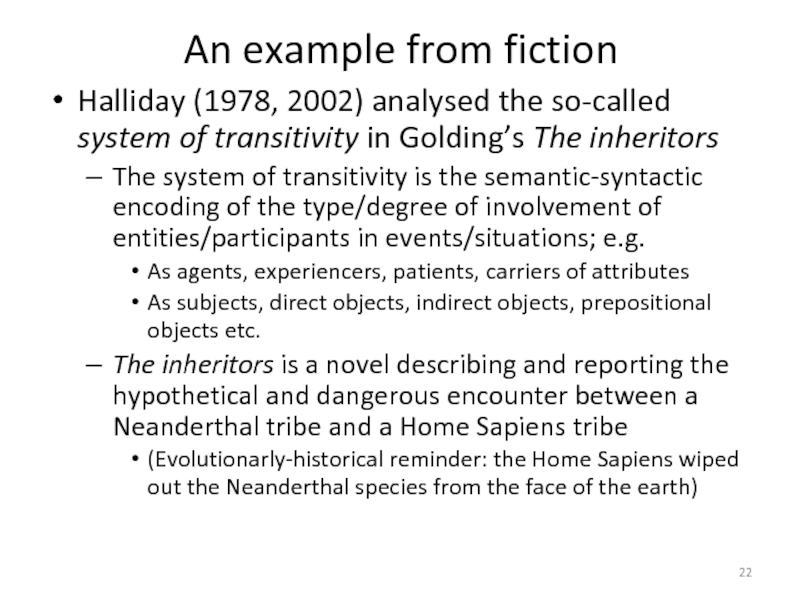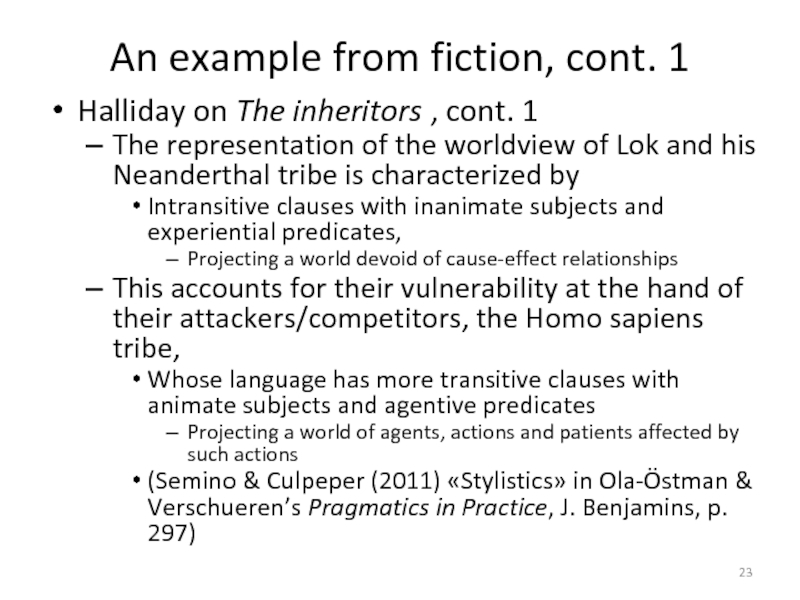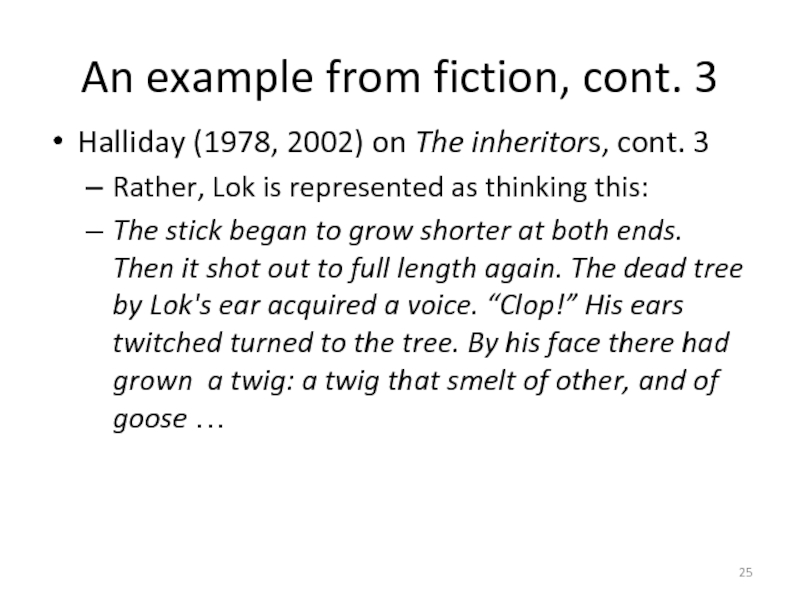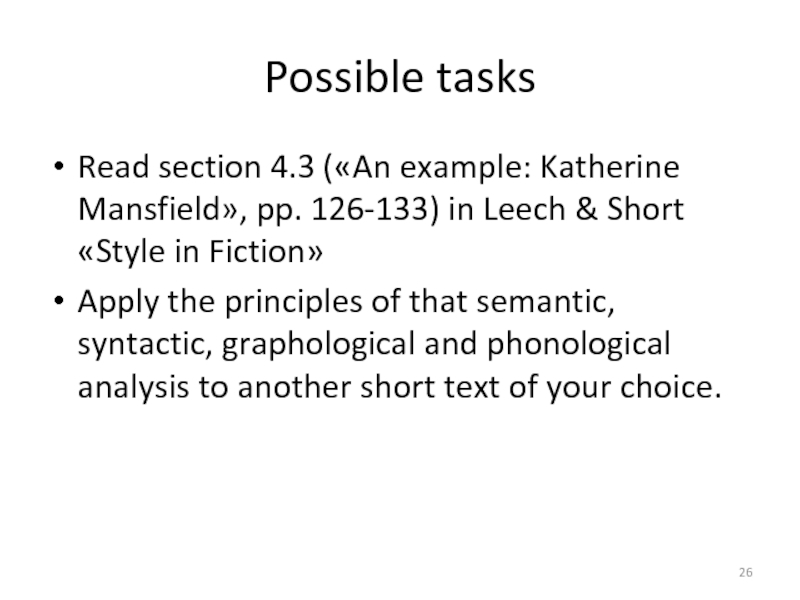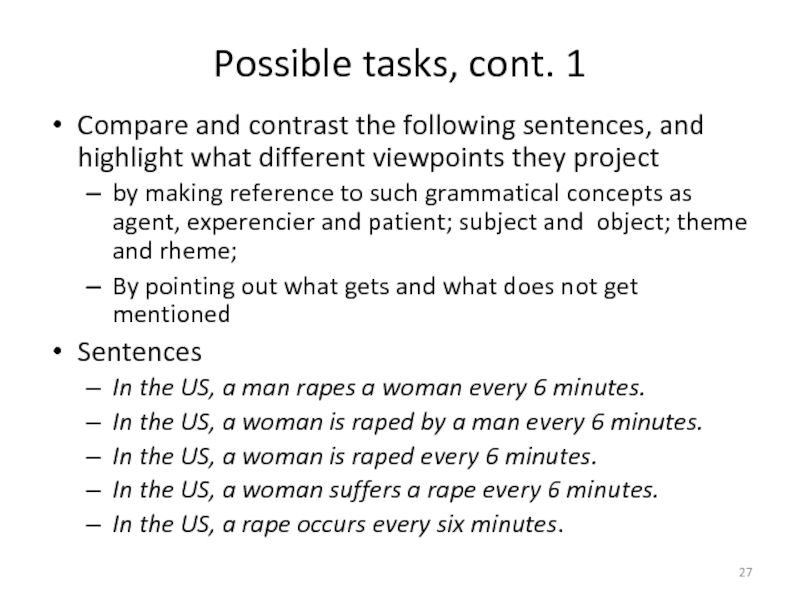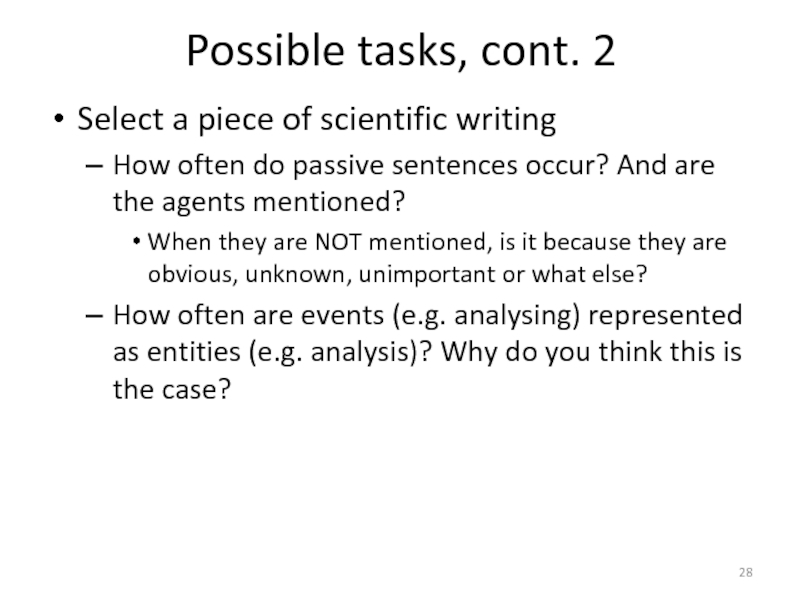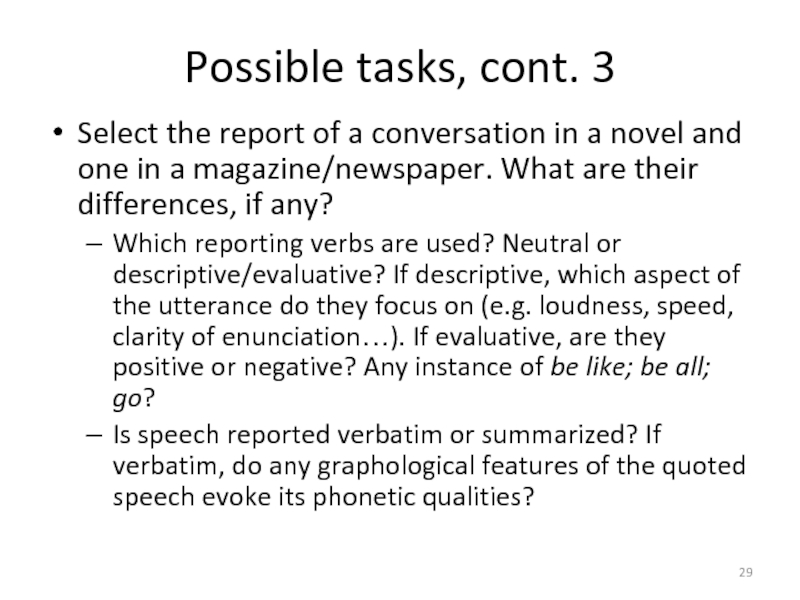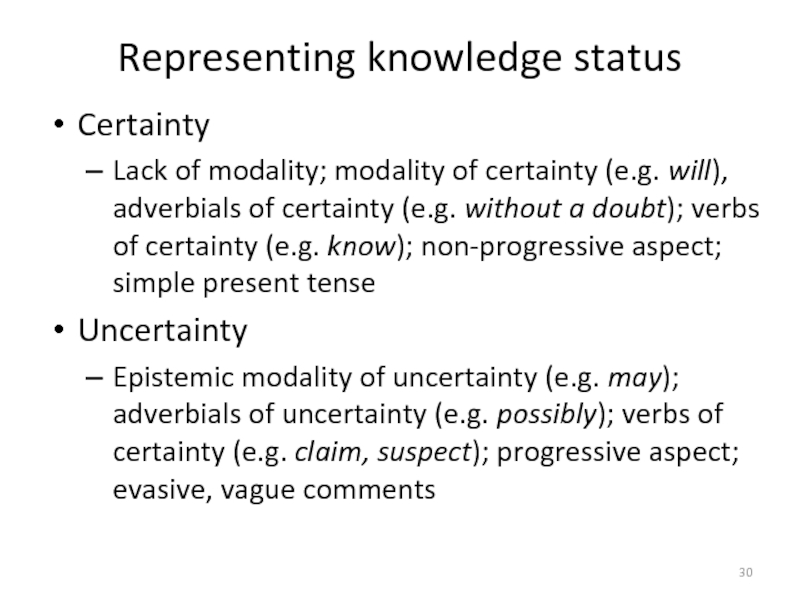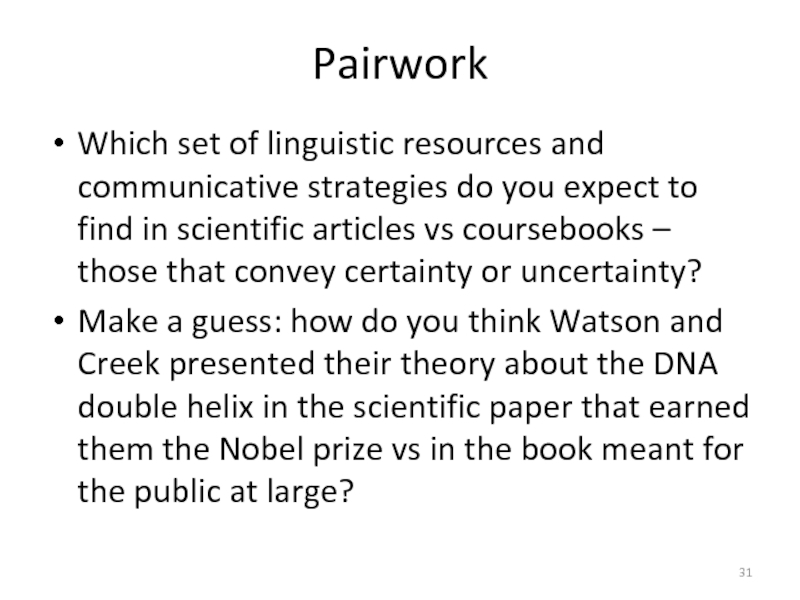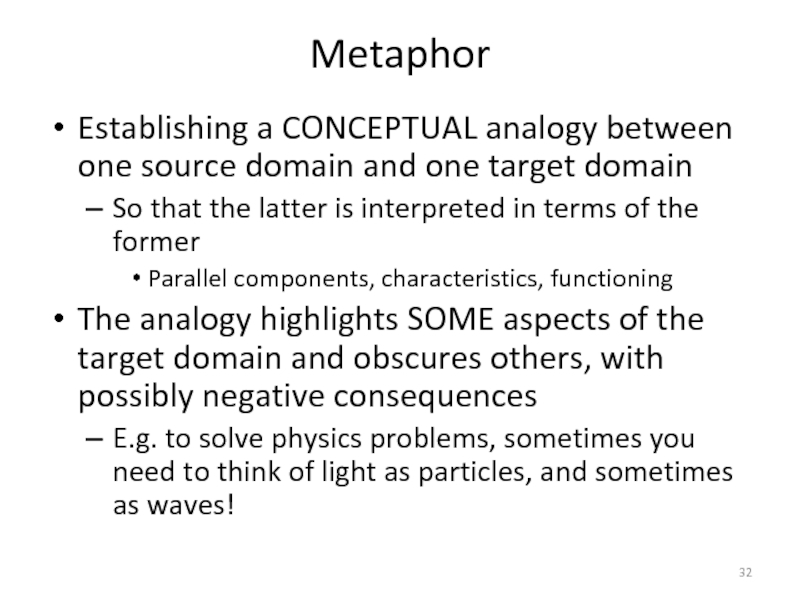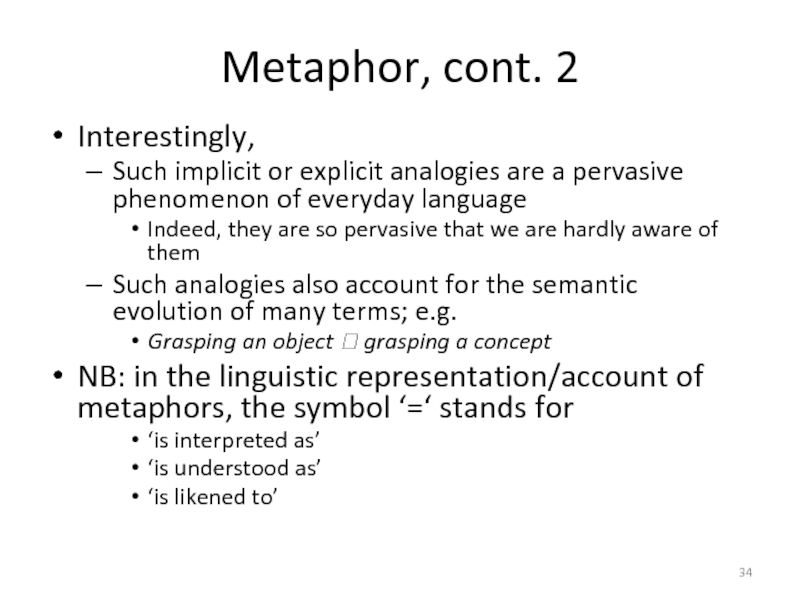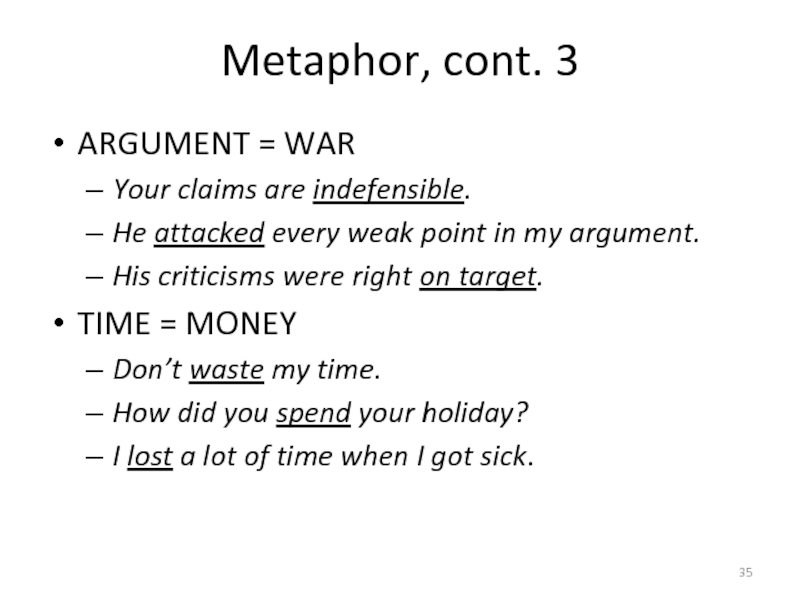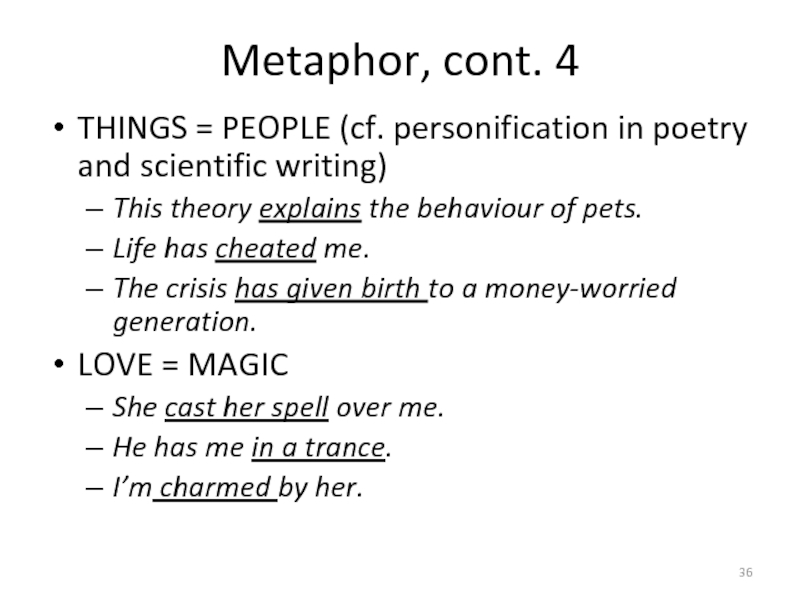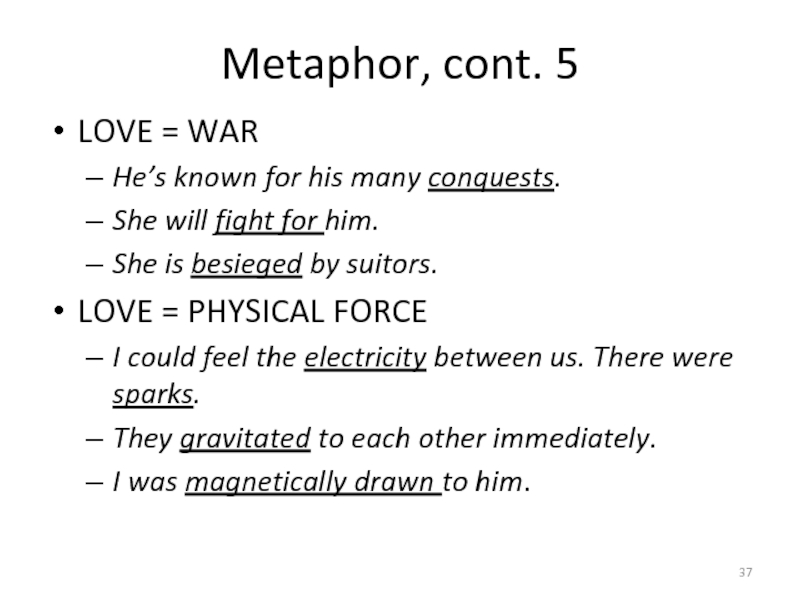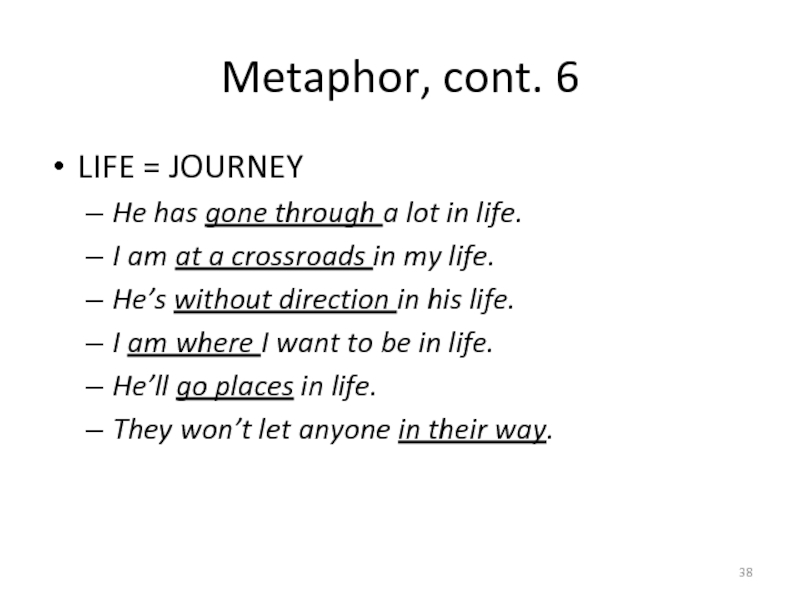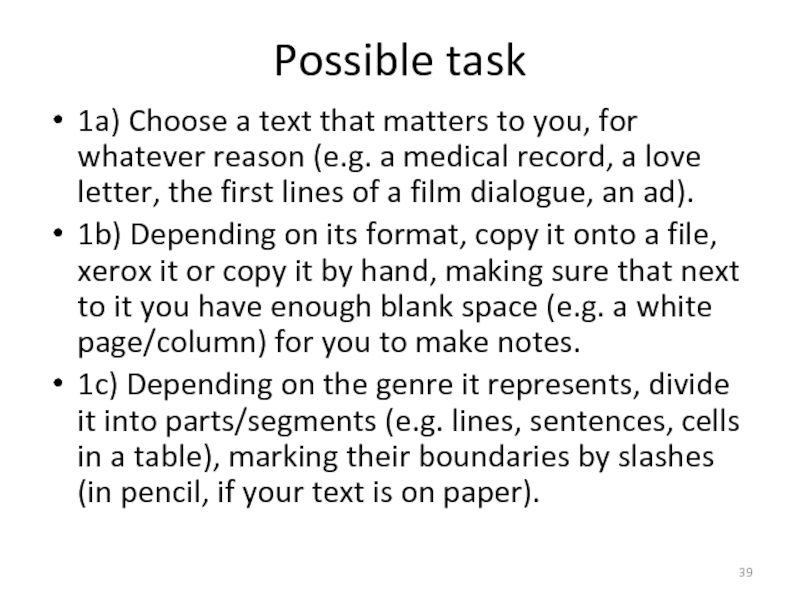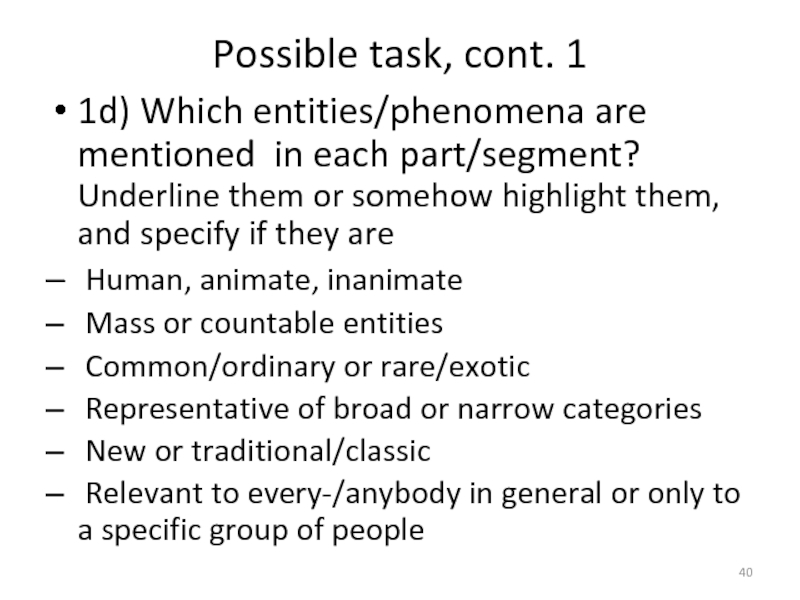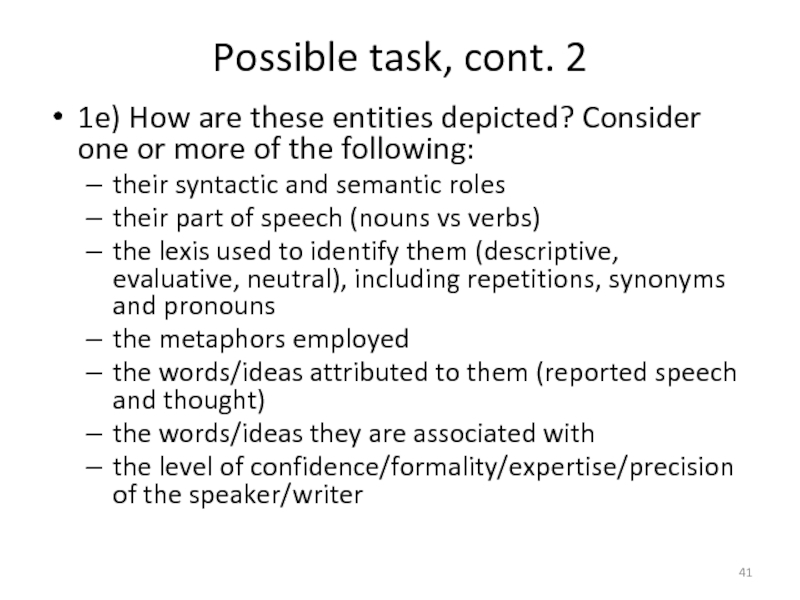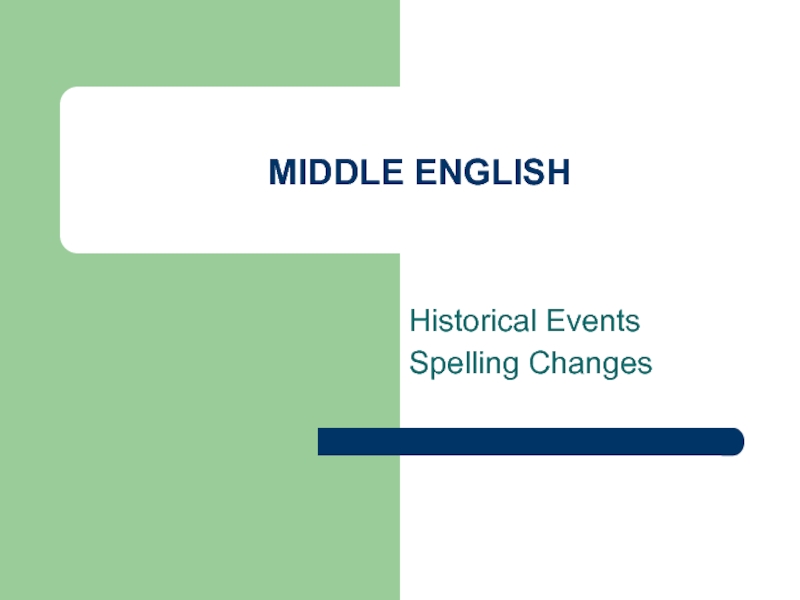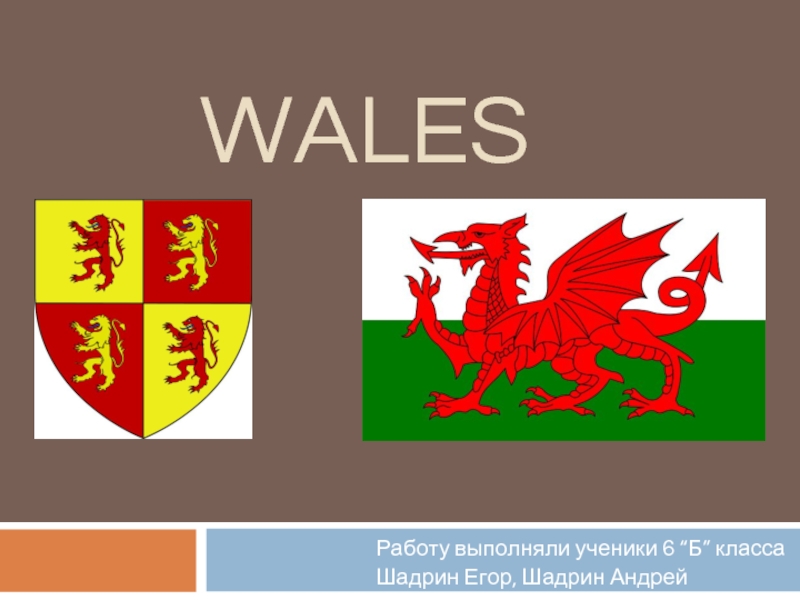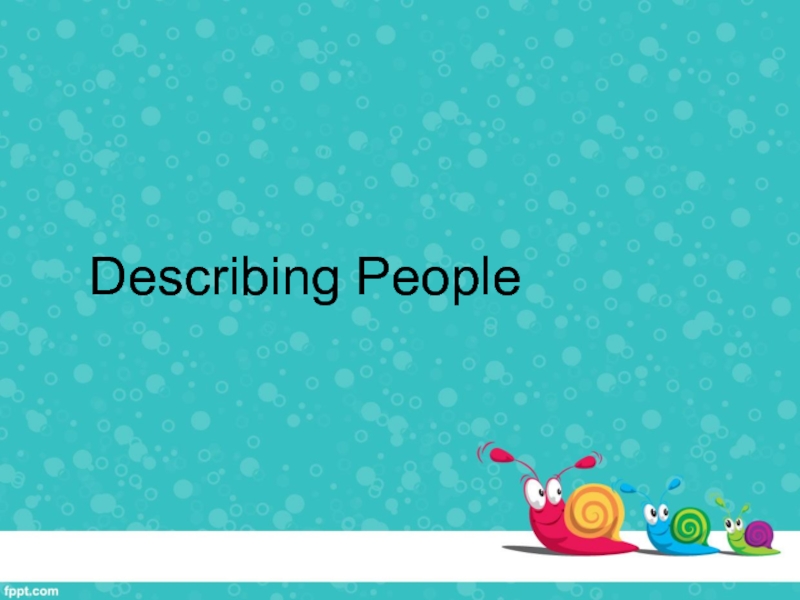- Главная
- Разное
- Дизайн
- Бизнес и предпринимательство
- Аналитика
- Образование
- Развлечения
- Красота и здоровье
- Финансы
- Государство
- Путешествия
- Спорт
- Недвижимость
- Армия
- Графика
- Культурология
- Еда и кулинария
- Лингвистика
- Английский язык
- Астрономия
- Алгебра
- Биология
- География
- Детские презентации
- Информатика
- История
- Литература
- Маркетинг
- Математика
- Медицина
- Менеджмент
- Музыка
- МХК
- Немецкий язык
- ОБЖ
- Обществознание
- Окружающий мир
- Педагогика
- Русский язык
- Технология
- Физика
- Философия
- Химия
- Шаблоны, картинки для презентаций
- Экология
- Экономика
- Юриспруденция
Form and content презентация
Содержание
- 1. Form and content
- 2. Outline The two-way relationship between the world
- 3. The world and its representation Theirs is
- 4. The world and its representation, cont. 1
- 5. The world and its representation, cont. 2
- 6. The world and its representation, cont.3 So,
- 7. Discussion Issues for you to consider Would
- 8. Discussion, cont. 1 Issues for you to
- 9. Discussion, cont. 2 Examples, cont. 2 Do
- 10. The world and its representation, cont. 4
- 11. The world and its representation, cont. 4
- 12. The world and its representation, cont. 2
- 13. A case in point Translation/ interpretation A
- 14. Possible task (repeated from Unit 1) Ia)
- 15. Discussion Have you ever been in a
- 16. Language and mind: categories When we have
- 17. Language and mind: categories, cont. 2 Grammatical
- 18. Language and mind: ideas The way we
- 19. Language and mind: ideas, cont. 2 Every
- 20. An example in journalese «About half of
- 21. An example in journalese, cont. 1 «About
- 22. An example from fiction Halliday (1978, 2002)
- 23. An example from fiction, cont. 1 Halliday
- 24. An example from fiction, cont. 2 Halliday
- 25. An example from fiction, cont. 3 Halliday
- 26. Possible tasks Read section 4.3 («An example:
- 27. Possible tasks, cont. 1 Compare and contrast
- 28. Possible tasks, cont. 2 Select a piece
- 29. Possible tasks, cont. 3 Select the report
- 30. Representing knowledge status Certainty Lack of modality;
- 31. Pairwork Which set of linguistic resources and
- 32. Metaphor Establishing a CONCEPTUAL analogy between one
- 33. Metaphor, cont. 1 NB: Unlike what happens
- 34. Metaphor, cont. 2 Interestingly, Such implicit or
- 35. Metaphor, cont. 3 ARGUMENT = WAR Your
- 36. Metaphor, cont. 4 THINGS = PEOPLE (cf.
- 37. Metaphor, cont. 5 LOVE = WAR He’s
- 38. Metaphor, cont. 6 LIFE = JOURNEY He
- 39. Possible task 1a) Choose a text that
- 40. Possible task, cont. 1 1d) Which entities/phenomena
- 41. Possible task, cont. 2 1e) How are
Слайд 2Outline
The two-way relationship between the world and its representation
The relationship between
language and mind
Categories
Ideas
Representing knowledge status
Understanding and explaining by analogy: metaphor
Categories
Ideas
Representing knowledge status
Understanding and explaining by analogy: metaphor
Слайд 3The world and its representation
Theirs is a two-way relationship
Discourse represents, describes,
mirrors the world
It is ABOUT the world, a reflection of it
It exists after and because of it
But it also reflects and creates worldviews
Naming practices associated with entities/ concepts/ phenomena give rise to ideas and fights over them!
Ways of talking/writing about with entities/ concepts/ phenomena affect our perception of them
It is ABOUT the world, a reflection of it
It exists after and because of it
But it also reflects and creates worldviews
Naming practices associated with entities/ concepts/ phenomena give rise to ideas and fights over them!
Ways of talking/writing about with entities/ concepts/ phenomena affect our perception of them
Слайд 4The world and its representation, cont. 1
Examples
The terms conflict, military action
and war may refer to one and the same phenomenon
However, the term war is used when the phenomenon
a) is given a proper name (and thus a unique identity),
b) is associated with a precise recognizable/acknowledged dated beginning and end and
c) is seen as endowed with historical significance
However, the term war is used when the phenomenon
a) is given a proper name (and thus a unique identity),
b) is associated with a precise recognizable/acknowledged dated beginning and end and
c) is seen as endowed with historical significance
Слайд 5The world and its representation, cont. 2
Examples, cont. 1
The terms competence,
effectiveness, mastery, facility, expertise identify some/the goals of foreign language education
The very existence of the terms presents the relevant goals as discrete, testable activities, whether this is the case or not
The very existence of the terms presents the relevant goals as discrete, testable activities, whether this is the case or not
Слайд 6The world and its representation, cont.3
So,
Given that the world does not
exist except in the way and to the extent that we make sense of it,
Then, depending on how we (un)consciously choose (not) to label it,
We effectively modify it
We hide/minimize vs highlight parts/aspects of it
Only what is explicitly labelled is recognized as existing
Its value and relevance depend on the degree of precision/vagueness, positivity/negativity, scope of applicability etc of its labels
Then, depending on how we (un)consciously choose (not) to label it,
We effectively modify it
We hide/minimize vs highlight parts/aspects of it
Only what is explicitly labelled is recognized as existing
Its value and relevance depend on the degree of precision/vagueness, positivity/negativity, scope of applicability etc of its labels
Слайд 7Discussion
Issues for you to consider
Would you tell a friend/yourself that he/she/you
is/are fat or overweight, stingy or thrifty?
How does the world change – or fail to change – depending on the label you choose to describe your friend/yourself?
Is stalking been a crime in your country? (It is in Italy, and/but an English term is used for it: why?)
What are the pro-life and the pro-choice movements for and against? How come neither movement calls itself the anti-X movement?
How does the world change – or fail to change – depending on the label you choose to describe your friend/yourself?
Is stalking been a crime in your country? (It is in Italy, and/but an English term is used for it: why?)
What are the pro-life and the pro-choice movements for and against? How come neither movement calls itself the anti-X movement?
Слайд 8Discussion, cont. 1
Issues for you to consider, cont. 1
Why do the
military use the terms casualties or collateral damage instead of deaths?
What’s the difference between genocide and ethnic cleansing?
Why would a spokesperson say «Our president expressed his sorrow but did not apologise»?
Why is it common to hear/read in English woman doctor but male model rather than man doctor and female model?
How often are females vs males described in terms of their physical appearance vs social roles?
What’s the difference between genocide and ethnic cleansing?
Why would a spokesperson say «Our president expressed his sorrow but did not apologise»?
Why is it common to hear/read in English woman doctor but male model rather than man doctor and female model?
How often are females vs males described in terms of their physical appearance vs social roles?
Слайд 9Discussion, cont. 2
Examples, cont. 2
Do your teachers ever call interesting something
that you would classify as difficult? If so, what does the choice of the term depend on, or at least correlate with?
Do you agree with the statement that every problem is an opportunity? Why or why not?
How do tests and examinations differ from evaluations and skills assessments? Do the terms stand for different concepts?
Do you agree with the statement that every problem is an opportunity? Why or why not?
How do tests and examinations differ from evaluations and skills assessments? Do the terms stand for different concepts?
Слайд 10The world and its representation, cont. 4
Alternative labels for the «same»
phenomenon affect the way in which we understand – or fail to understand – it.
Indeed, it is as if we were wearing different pairs glasses when looking at it
Indeed, it is as if we were wearing different pairs glasses when looking at it
Слайд 11The world and its representation, cont. 4
Examples, cont. 3
In an experimental
study (Clark, Clark 1977), two groups of subjects were assigned a manual task (fixing a candle to a wall in an upright position so that the wax would not drip). To be able to perform it, they were given some tools (a candle, tacks, matches, a box), which were explicitly named only to one group. This latter group took less time to perform the task.
Imagine that the tools had been named to both groups, and that one was told they had a «box» while the other «a box of matches». What different outcome, if any, would you have expected?
Imagine that the tools had been named to both groups, and that one was told they had a «box» while the other «a box of matches». What different outcome, if any, would you have expected?
Слайд 12The world and its representation, cont. 2
Examples, cont. 4
The initial foray
into understanding the nature of leukemia happened when, in the 1840s, Virchow changed the name of the disease from «suppuration of blood» to «weisses Blut» (‘white blood’ > leukemia)
The former name had preconceptions built into it (it classified the disease by labelling its supposed origin: ‘the formation/discharge of pus’)
The latter was merely descriptive of its apparent characteristics, which cleared the field for humble, unbiased research
Research questions: why is it white? Why is it so white? Could it be because there are more and/or bigger white cells than there usually are?
(Discussion question: Why do you think ‘white blood’ was then renamed leukemia?)
The former name had preconceptions built into it (it classified the disease by labelling its supposed origin: ‘the formation/discharge of pus’)
The latter was merely descriptive of its apparent characteristics, which cleared the field for humble, unbiased research
Research questions: why is it white? Why is it so white? Could it be because there are more and/or bigger white cells than there usually are?
(Discussion question: Why do you think ‘white blood’ was then renamed leukemia?)
Слайд 13A case in point
Translation/ interpretation
A language gives its speakers verbal categories
that function as frames and boxes into which to fit entities and phenomena
So as to lump them together or differentiate them
Moving from one language/variety to another, or even resorting to paraphrasing, means adding meanings that were not in the original and/or omitting something that was
So as to lump them together or differentiate them
Moving from one language/variety to another, or even resorting to paraphrasing, means adding meanings that were not in the original and/or omitting something that was
Слайд 14Possible task (repeated from Unit 1)
Ia) Consider the following statements and
translate them into a language you are very proficient in
All men are created equal.
Don’t count your chickens before they hatch.
Ib) Keep track of the decisions you have to make and what motivates them. Does anything get lost? Is anything gained? Why or why not? And what for, if anything?
All men are created equal.
Don’t count your chickens before they hatch.
Ib) Keep track of the decisions you have to make and what motivates them. Does anything get lost? Is anything gained? Why or why not? And what for, if anything?
Слайд 15Discussion
Have you ever been in a situation in which you didn’t
know the language of the people around you? How did that make you feel?
Do bilinguals think, act, feel differently in their two languages?
Can we conceive of things we cannot talk about?
Do bilinguals think, act, feel differently in their two languages?
Can we conceive of things we cannot talk about?
Слайд 16Language and mind: categories
When we have a name for a group/class
of entities/phenomena
We tend to think of them as being similar
Either all sharing something
Or resembling each other like family members
Pairwork: Compare the terms and concepts HAIR, CARD, DRY, FRIEND, INFORMATION, CHILD with their «equivalents» in your language
How is «reality» segmented/perceived differently in English vs the other language?
We tend to think of them as being similar
Either all sharing something
Or resembling each other like family members
Pairwork: Compare the terms and concepts HAIR, CARD, DRY, FRIEND, INFORMATION, CHILD with their «equivalents» in your language
How is «reality» segmented/perceived differently in English vs the other language?
Слайд 17Language and mind: categories, cont. 2
Grammatical distinctions encourage us to think
of entities/phenomena as having all-or-none properties
E.g. English nouns can be definite/indefinite, singular/plural, mass/count and their referents are conceived of as having, or not having, indeed their properties
But other languages favour, e.g., gender distinctions and/or use classifiers (cf. English a loaf/ bunch/ piece/pair of… bread/ flowers/ advice/scissors)
E.g. English nouns can be definite/indefinite, singular/plural, mass/count and their referents are conceived of as having, or not having, indeed their properties
But other languages favour, e.g., gender distinctions and/or use classifiers (cf. English a loaf/ bunch/ piece/pair of… bread/ flowers/ advice/scissors)
Слайд 18Language and mind: ideas
The way we talk about entities/phenomena affects how
we make sense of them
Compare
I am married (this is a quality that characterises me) vs
I have a wife/husband (I possess someone, who belongs to me)
The baby is asleep (that’s his/her current state)
The baby is sleeping (that’s what he/she is doing right now)
I overreacted (I am the agent responsible for what happened)
You made me do it (I ascribe to YOU responsibility for what happened)
I’m sorry about that (I feel sympathy towards you), but I won’t apologise for it (I am not responsible for it)
Compare
I am married (this is a quality that characterises me) vs
I have a wife/husband (I possess someone, who belongs to me)
The baby is asleep (that’s his/her current state)
The baby is sleeping (that’s what he/she is doing right now)
I overreacted (I am the agent responsible for what happened)
You made me do it (I ascribe to YOU responsibility for what happened)
I’m sorry about that (I feel sympathy towards you), but I won’t apologise for it (I am not responsible for it)
Слайд 19Language and mind: ideas, cont. 2
Every linguistic choice is never neutral,
innocent or without consequences
It is an act of selection of an option among many, and thus also an act of omission/exclusion of the other options
It presents a «way of seeing/interpreting» as natural, as THE default/obvious – and thus invisible – way of seeing/interpreting
It helps create – or cannot but create – a favourite/prevalent point of view
It is an act of selection of an option among many, and thus also an act of omission/exclusion of the other options
It presents a «way of seeing/interpreting» as natural, as THE default/obvious – and thus invisible – way of seeing/interpreting
It helps create – or cannot but create – a favourite/prevalent point of view
Слайд 20An example in journalese
«About half of our patients will see a
long-term, possibly permanent response to these drugs while the other half may begin to exhibit disease progression again»
First clause: Patients represented as experiencers (visual perceivers of their disease), not people in charge/control of their lives or people in need of care
Second clause: the perspective adopted is that of the doctor looking at the patient, while this is represented as the sight/location of «disease progression»
«Disease progression»: disease represented as goal-oriented/driven or at least as possibly evolving over time
First clause: Patients represented as experiencers (visual perceivers of their disease), not people in charge/control of their lives or people in need of care
Second clause: the perspective adopted is that of the doctor looking at the patient, while this is represented as the sight/location of «disease progression»
«Disease progression»: disease represented as goal-oriented/driven or at least as possibly evolving over time
Слайд 21An example in journalese, cont. 1
«About half of our patients […
]»
The mini-report technically and accurately describes and accounts for a phenomenon
But how this phenomenon affects and/or is perceived by the participants involved is left out of the picture, as irrelevant.
The mini-report technically and accurately describes and accounts for a phenomenon
But how this phenomenon affects and/or is perceived by the participants involved is left out of the picture, as irrelevant.
Слайд 22An example from fiction
Halliday (1978, 2002) analysed the so-called system of
transitivity in Golding’s The inheritors
The system of transitivity is the semantic-syntactic encoding of the type/degree of involvement of entities/participants in events/situations; e.g.
As agents, experiencers, patients, carriers of attributes
As subjects, direct objects, indirect objects, prepositional objects etc.
The inheritors is a novel describing and reporting the hypothetical and dangerous encounter between a Neanderthal tribe and a Home Sapiens tribe
(Evolutionarly-historical reminder: the Home Sapiens wiped out the Neanderthal species from the face of the earth)
The system of transitivity is the semantic-syntactic encoding of the type/degree of involvement of entities/participants in events/situations; e.g.
As agents, experiencers, patients, carriers of attributes
As subjects, direct objects, indirect objects, prepositional objects etc.
The inheritors is a novel describing and reporting the hypothetical and dangerous encounter between a Neanderthal tribe and a Home Sapiens tribe
(Evolutionarly-historical reminder: the Home Sapiens wiped out the Neanderthal species from the face of the earth)
Слайд 23An example from fiction, cont. 1
Halliday on The inheritors , cont.
1
The representation of the worldview of Lok and his Neanderthal tribe is characterized by
Intransitive clauses with inanimate subjects and experiential predicates,
Projecting a world devoid of cause-effect relationships
This accounts for their vulnerability at the hand of their attackers/competitors, the Homo sapiens tribe,
Whose language has more transitive clauses with animate subjects and agentive predicates
Projecting a world of agents, actions and patients affected by such actions
(Semino & Culpeper (2011) «Stylistics» in Ola-Östman & Verschueren’s Pragmatics in Practice, J. Benjamins, p. 297)
The representation of the worldview of Lok and his Neanderthal tribe is characterized by
Intransitive clauses with inanimate subjects and experiential predicates,
Projecting a world devoid of cause-effect relationships
This accounts for their vulnerability at the hand of their attackers/competitors, the Homo sapiens tribe,
Whose language has more transitive clauses with animate subjects and agentive predicates
Projecting a world of agents, actions and patients affected by such actions
(Semino & Culpeper (2011) «Stylistics» in Ola-Östman & Verschueren’s Pragmatics in Practice, J. Benjamins, p. 297)
Слайд 24An example from fiction, cont. 2
Halliday (1978, 2002) on The inheritors,
cont. 2
Example: when Lok is first attacked by a Home Sapiens, he is not represented as thinking/understanding what «really» happens like this:
Someone drew a bow and shot an arrow at me, which missed me by an inch and instead hit the dead tree by my side.
Example: when Lok is first attacked by a Home Sapiens, he is not represented as thinking/understanding what «really» happens like this:
Someone drew a bow and shot an arrow at me, which missed me by an inch and instead hit the dead tree by my side.
Слайд 25An example from fiction, cont. 3
Halliday (1978, 2002) on The inheritors,
cont. 3
Rather, Lok is represented as thinking this:
The stick began to grow shorter at both ends. Then it shot out to full length again. The dead tree by Lok's ear acquired a voice. “Clop!” His ears twitched turned to the tree. By his face there had grown a twig: a twig that smelt of other, and of goose …
Rather, Lok is represented as thinking this:
The stick began to grow shorter at both ends. Then it shot out to full length again. The dead tree by Lok's ear acquired a voice. “Clop!” His ears twitched turned to the tree. By his face there had grown a twig: a twig that smelt of other, and of goose …
Слайд 26Possible tasks
Read section 4.3 («An example: Katherine Mansfield», pp. 126-133) in
Leech & Short «Style in Fiction»
Apply the principles of that semantic, syntactic, graphological and phonological analysis to another short text of your choice.
Apply the principles of that semantic, syntactic, graphological and phonological analysis to another short text of your choice.
Слайд 27Possible tasks, cont. 1
Compare and contrast the following sentences, and highlight
what different viewpoints they project
by making reference to such grammatical concepts as agent, experencier and patient; subject and object; theme and rheme;
By pointing out what gets and what does not get mentioned
Sentences
In the US, a man rapes a woman every 6 minutes.
In the US, a woman is raped by a man every 6 minutes.
In the US, a woman is raped every 6 minutes.
In the US, a woman suffers a rape every 6 minutes.
In the US, a rape occurs every six minutes.
by making reference to such grammatical concepts as agent, experencier and patient; subject and object; theme and rheme;
By pointing out what gets and what does not get mentioned
Sentences
In the US, a man rapes a woman every 6 minutes.
In the US, a woman is raped by a man every 6 minutes.
In the US, a woman is raped every 6 minutes.
In the US, a woman suffers a rape every 6 minutes.
In the US, a rape occurs every six minutes.
Слайд 28Possible tasks, cont. 2
Select a piece of scientific writing
How often do
passive sentences occur? And are the agents mentioned?
When they are NOT mentioned, is it because they are obvious, unknown, unimportant or what else?
How often are events (e.g. analysing) represented as entities (e.g. analysis)? Why do you think this is the case?
When they are NOT mentioned, is it because they are obvious, unknown, unimportant or what else?
How often are events (e.g. analysing) represented as entities (e.g. analysis)? Why do you think this is the case?
Слайд 29Possible tasks, cont. 3
Select the report of a conversation in a
novel and one in a magazine/newspaper. What are their differences, if any?
Which reporting verbs are used? Neutral or descriptive/evaluative? If descriptive, which aspect of the utterance do they focus on (e.g. loudness, speed, clarity of enunciation…). If evaluative, are they positive or negative? Any instance of be like; be all; go?
Is speech reported verbatim or summarized? If verbatim, do any graphological features of the quoted speech evoke its phonetic qualities?
Which reporting verbs are used? Neutral or descriptive/evaluative? If descriptive, which aspect of the utterance do they focus on (e.g. loudness, speed, clarity of enunciation…). If evaluative, are they positive or negative? Any instance of be like; be all; go?
Is speech reported verbatim or summarized? If verbatim, do any graphological features of the quoted speech evoke its phonetic qualities?
Слайд 30Representing knowledge status
Certainty
Lack of modality; modality of certainty (e.g. will), adverbials
of certainty (e.g. without a doubt); verbs of certainty (e.g. know); non-progressive aspect; simple present tense
Uncertainty
Epistemic modality of uncertainty (e.g. may); adverbials of uncertainty (e.g. possibly); verbs of certainty (e.g. claim, suspect); progressive aspect; evasive, vague comments
Uncertainty
Epistemic modality of uncertainty (e.g. may); adverbials of uncertainty (e.g. possibly); verbs of certainty (e.g. claim, suspect); progressive aspect; evasive, vague comments
Слайд 31Pairwork
Which set of linguistic resources and communicative strategies do you expect
to find in scientific articles vs coursebooks – those that convey certainty or uncertainty?
Make a guess: how do you think Watson and Creek presented their theory about the DNA double helix in the scientific paper that earned them the Nobel prize vs in the book meant for the public at large?
Make a guess: how do you think Watson and Creek presented their theory about the DNA double helix in the scientific paper that earned them the Nobel prize vs in the book meant for the public at large?
Слайд 32Metaphor
Establishing a CONCEPTUAL analogy between one source domain and one target
domain
So that the latter is interpreted in terms of the former
Parallel components, characteristics, functioning
The analogy highlights SOME aspects of the target domain and obscures others, with possibly negative consequences
E.g. to solve physics problems, sometimes you need to think of light as particles, and sometimes as waves!
So that the latter is interpreted in terms of the former
Parallel components, characteristics, functioning
The analogy highlights SOME aspects of the target domain and obscures others, with possibly negative consequences
E.g. to solve physics problems, sometimes you need to think of light as particles, and sometimes as waves!
Слайд 33Metaphor, cont. 1
NB: Unlike what happens in literature, in (cognitive) linguistics,
NO formal distinction is made between
A simile (e.g. Your eyes are like blue lakes) and
A metaphor (e.g. Your eyes are blue lakes)
That is, the overt or covert marking of the analogy in its verbal encoding is irrelevant
As long as an analogy is established
A simile (e.g. Your eyes are like blue lakes) and
A metaphor (e.g. Your eyes are blue lakes)
That is, the overt or covert marking of the analogy in its verbal encoding is irrelevant
As long as an analogy is established
Слайд 34Metaphor, cont. 2
Interestingly,
Such implicit or explicit analogies are a pervasive phenomenon
of everyday language
Indeed, they are so pervasive that we are hardly aware of them
Such analogies also account for the semantic evolution of many terms; e.g.
Grasping an object ? grasping a concept
NB: in the linguistic representation/account of metaphors, the symbol ‘=‘ stands for
‘is interpreted as’
‘is understood as’
‘is likened to’
Indeed, they are so pervasive that we are hardly aware of them
Such analogies also account for the semantic evolution of many terms; e.g.
Grasping an object ? grasping a concept
NB: in the linguistic representation/account of metaphors, the symbol ‘=‘ stands for
‘is interpreted as’
‘is understood as’
‘is likened to’
Слайд 35Metaphor, cont. 3
ARGUMENT = WAR
Your claims are indefensible.
He attacked every weak
point in my argument.
His criticisms were right on target.
TIME = MONEY
Don’t waste my time.
How did you spend your holiday?
I lost a lot of time when I got sick.
His criticisms were right on target.
TIME = MONEY
Don’t waste my time.
How did you spend your holiday?
I lost a lot of time when I got sick.
Слайд 36Metaphor, cont. 4
THINGS = PEOPLE (cf. personification in poetry and scientific
writing)
This theory explains the behaviour of pets.
Life has cheated me.
The crisis has given birth to a money-worried generation.
LOVE = MAGIC
She cast her spell over me.
He has me in a trance.
I’m charmed by her.
This theory explains the behaviour of pets.
Life has cheated me.
The crisis has given birth to a money-worried generation.
LOVE = MAGIC
She cast her spell over me.
He has me in a trance.
I’m charmed by her.
Слайд 37Metaphor, cont. 5
LOVE = WAR
He’s known for his many conquests.
She will
fight for him.
She is besieged by suitors.
LOVE = PHYSICAL FORCE
I could feel the electricity between us. There were sparks.
They gravitated to each other immediately.
I was magnetically drawn to him.
She is besieged by suitors.
LOVE = PHYSICAL FORCE
I could feel the electricity between us. There were sparks.
They gravitated to each other immediately.
I was magnetically drawn to him.
Слайд 38Metaphor, cont. 6
LIFE = JOURNEY
He has gone through a lot in
life.
I am at a crossroads in my life.
He’s without direction in his life.
I am where I want to be in life.
He’ll go places in life.
They won’t let anyone in their way.
I am at a crossroads in my life.
He’s without direction in his life.
I am where I want to be in life.
He’ll go places in life.
They won’t let anyone in their way.
Слайд 39Possible task
1a) Choose a text that matters to you, for whatever
reason (e.g. a medical record, a love letter, the first lines of a film dialogue, an ad).
1b) Depending on its format, copy it onto a file, xerox it or copy it by hand, making sure that next to it you have enough blank space (e.g. a white page/column) for you to make notes.
1c) Depending on the genre it represents, divide it into parts/segments (e.g. lines, sentences, cells in a table), marking their boundaries by slashes (in pencil, if your text is on paper).
1b) Depending on its format, copy it onto a file, xerox it or copy it by hand, making sure that next to it you have enough blank space (e.g. a white page/column) for you to make notes.
1c) Depending on the genre it represents, divide it into parts/segments (e.g. lines, sentences, cells in a table), marking their boundaries by slashes (in pencil, if your text is on paper).
Слайд 40Possible task, cont. 1
1d) Which entities/phenomena are mentioned in each part/segment?
Underline them or somehow highlight them, and specify if they are
Human, animate, inanimate
Mass or countable entities
Common/ordinary or rare/exotic
Representative of broad or narrow categories
New or traditional/classic
Relevant to every-/anybody in general or only to a specific group of people
Human, animate, inanimate
Mass or countable entities
Common/ordinary or rare/exotic
Representative of broad or narrow categories
New or traditional/classic
Relevant to every-/anybody in general or only to a specific group of people
Слайд 41Possible task, cont. 2
1e) How are these entities depicted? Consider one
or more of the following:
their syntactic and semantic roles
their part of speech (nouns vs verbs)
the lexis used to identify them (descriptive, evaluative, neutral), including repetitions, synonyms and pronouns
the metaphors employed
the words/ideas attributed to them (reported speech and thought)
the words/ideas they are associated with
the level of confidence/formality/expertise/precision of the speaker/writer
their syntactic and semantic roles
their part of speech (nouns vs verbs)
the lexis used to identify them (descriptive, evaluative, neutral), including repetitions, synonyms and pronouns
the metaphors employed
the words/ideas attributed to them (reported speech and thought)
the words/ideas they are associated with
the level of confidence/formality/expertise/precision of the speaker/writer

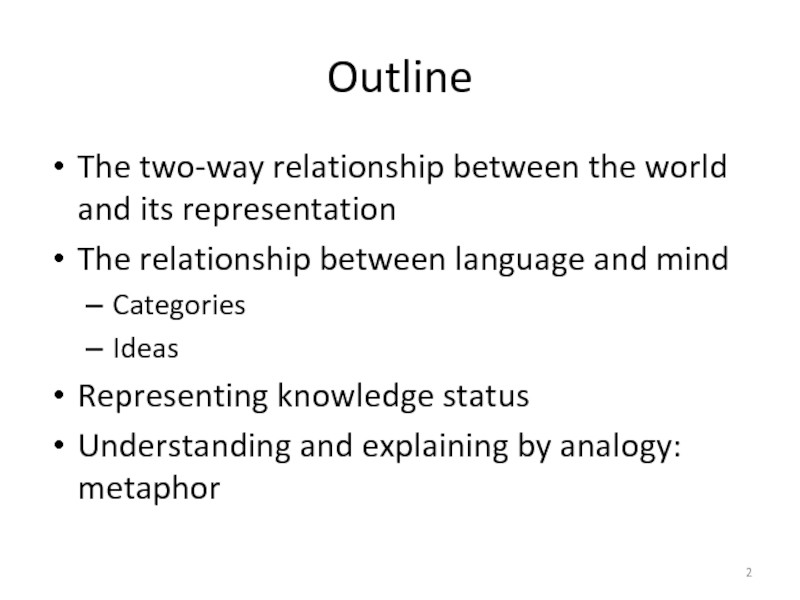
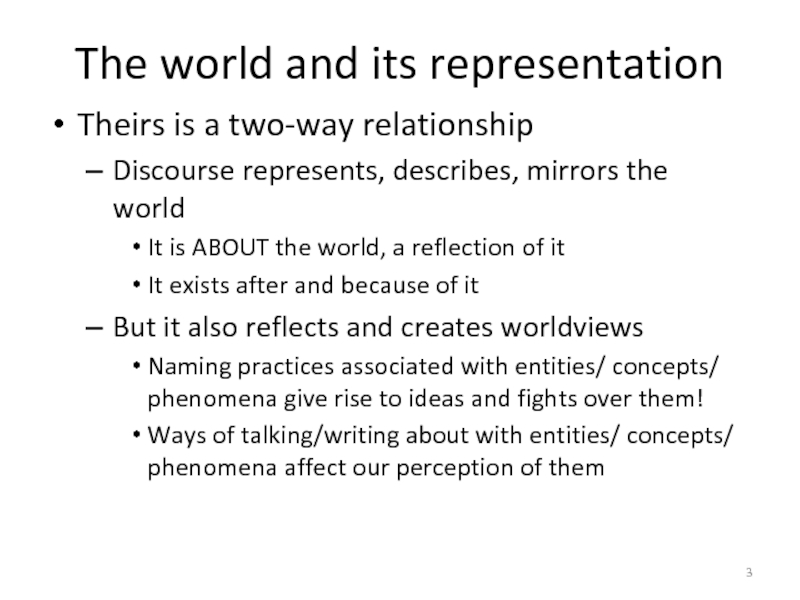
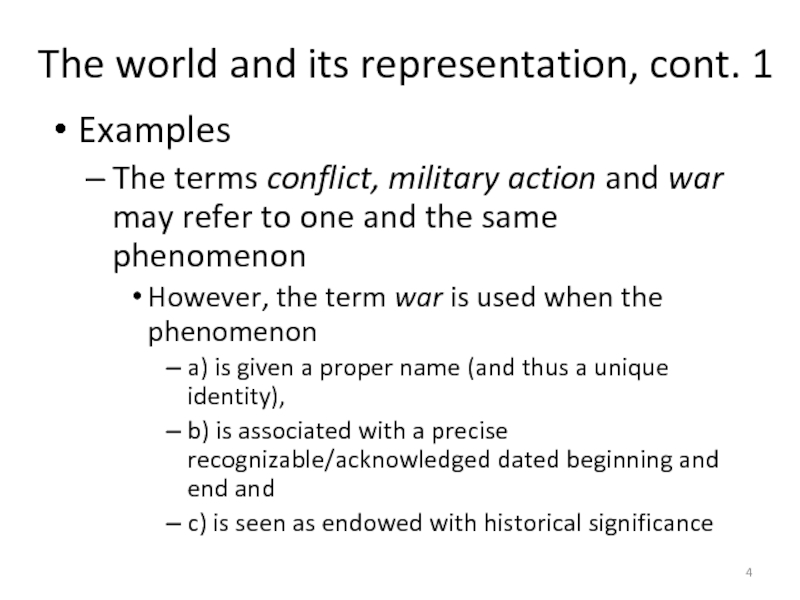
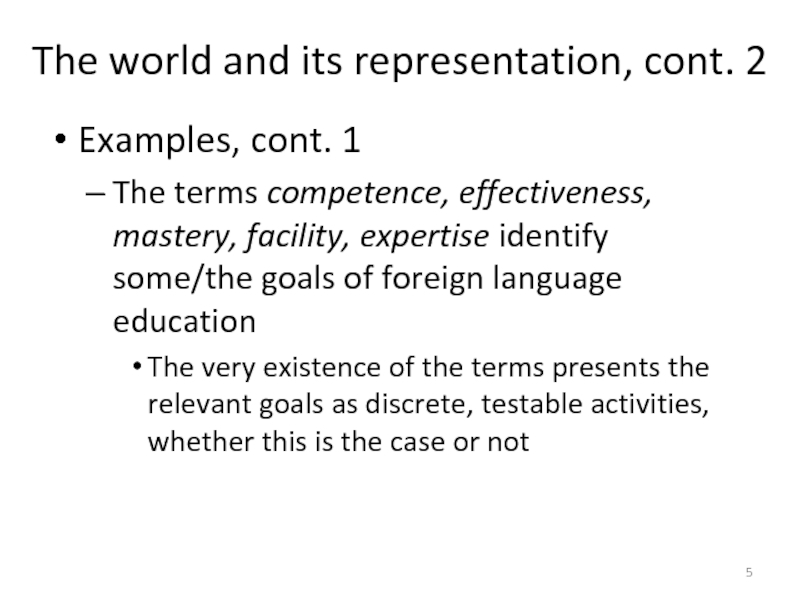
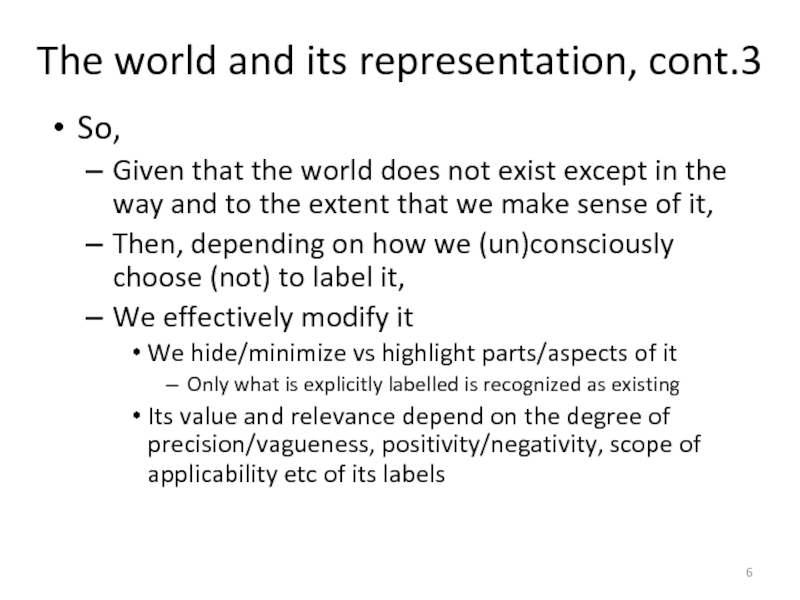
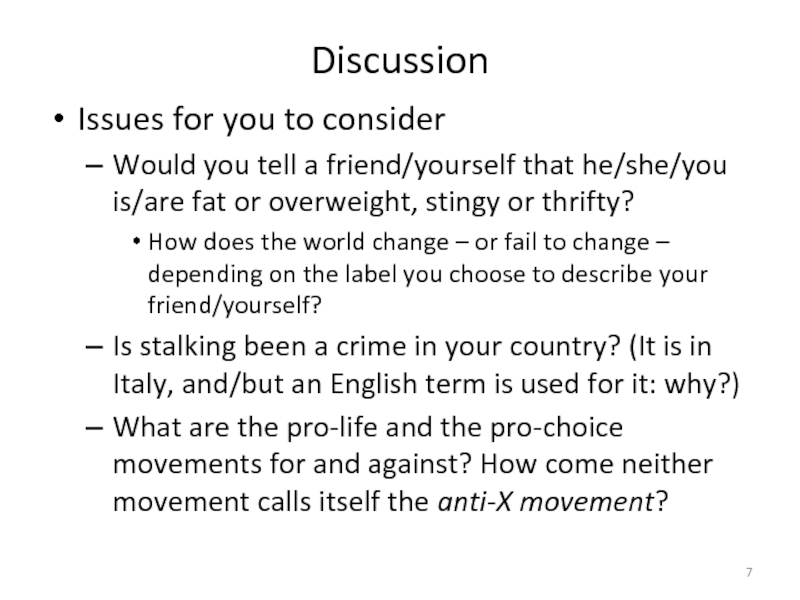
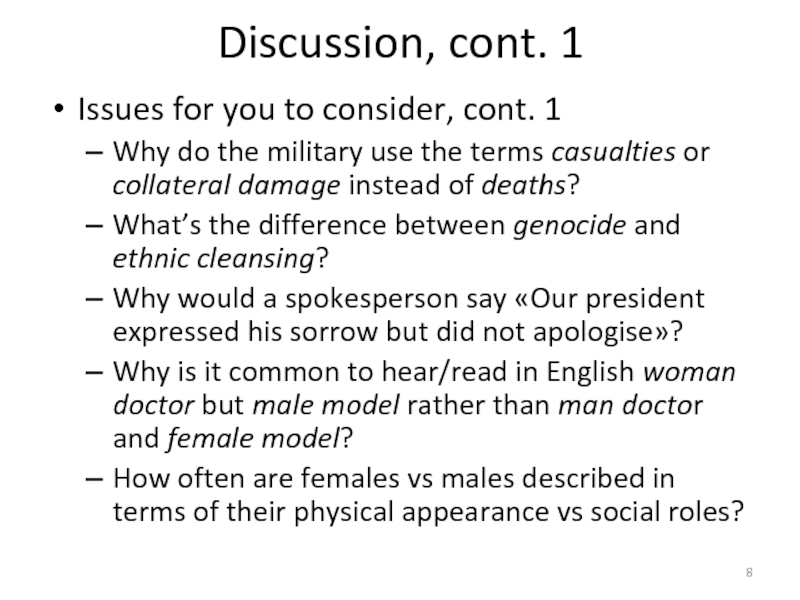
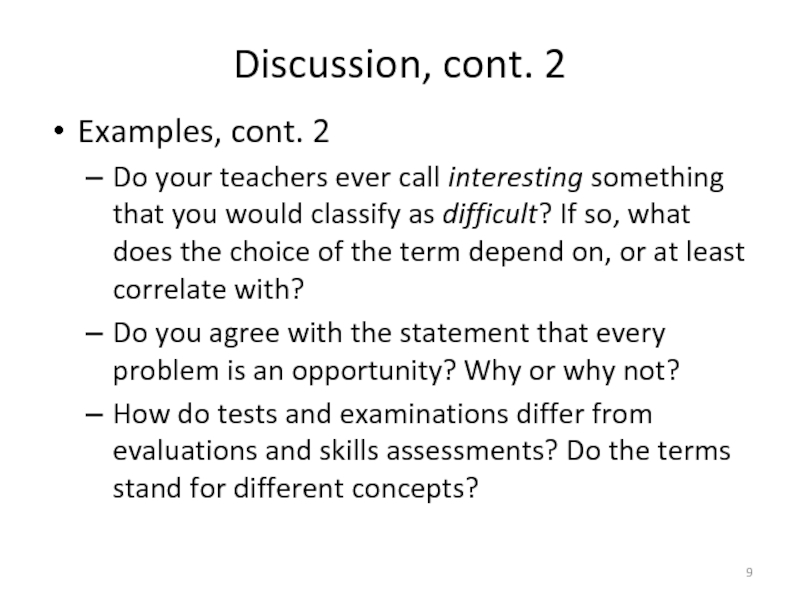
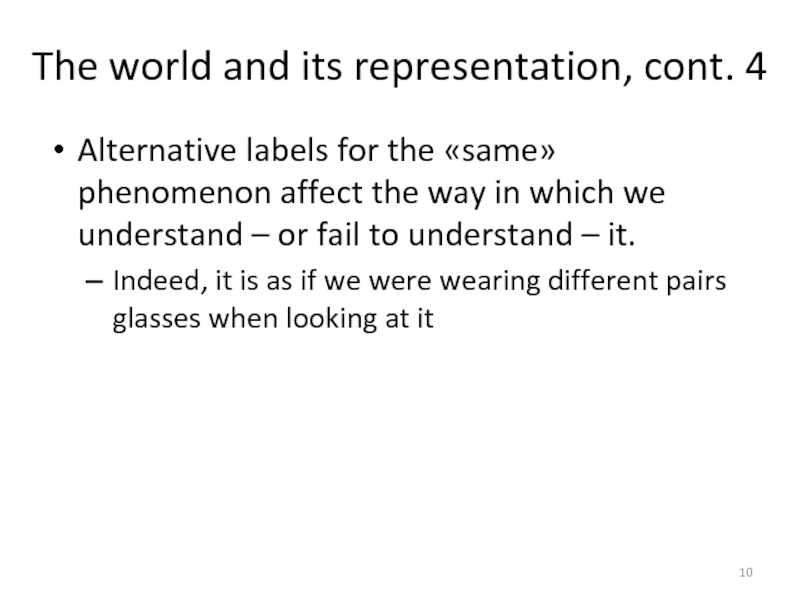
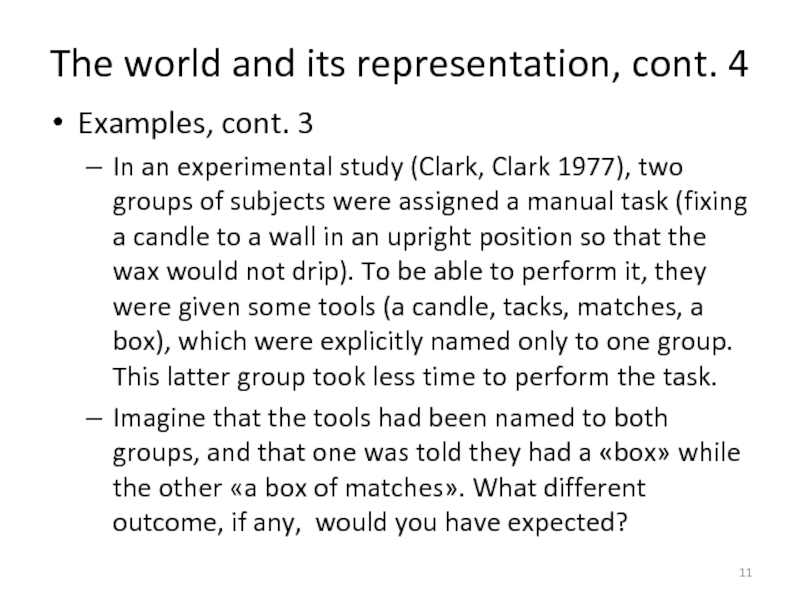
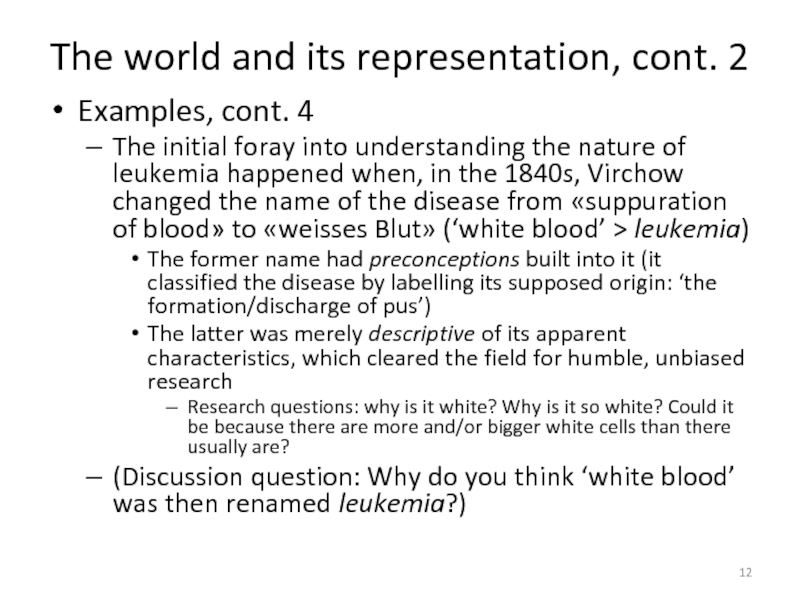
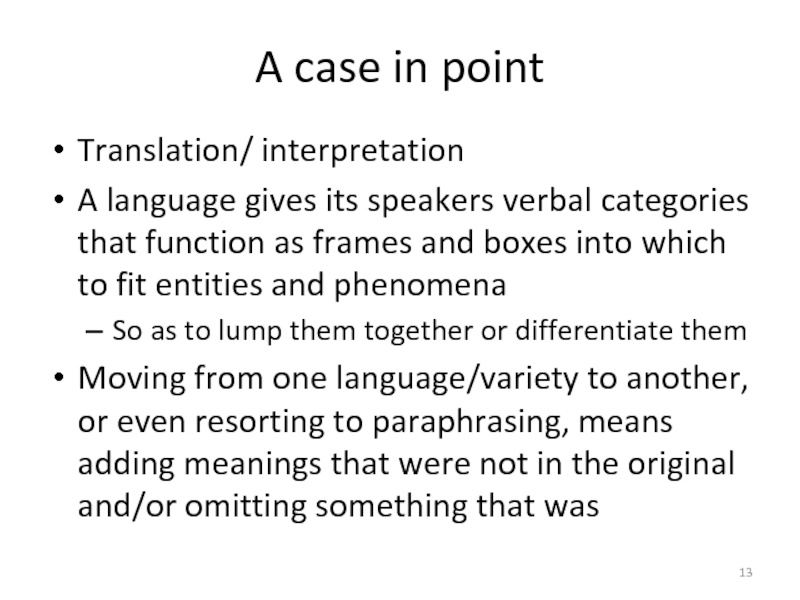
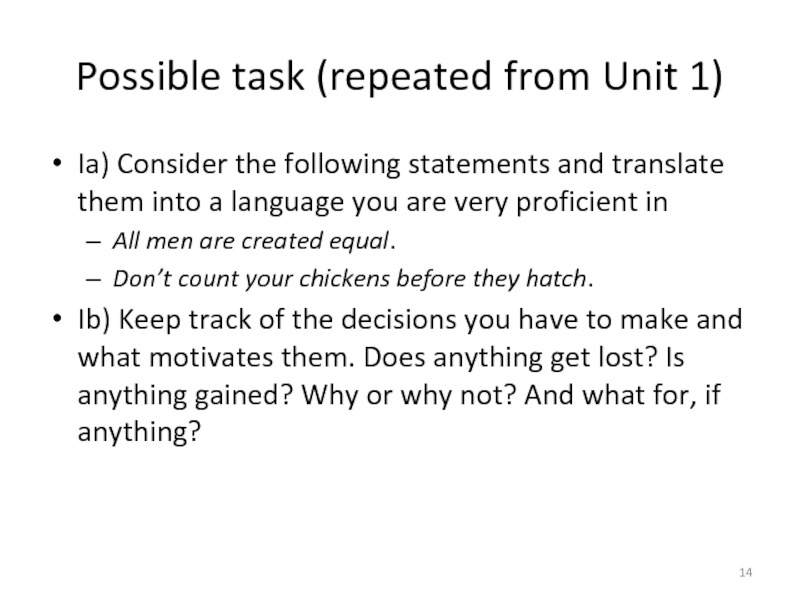
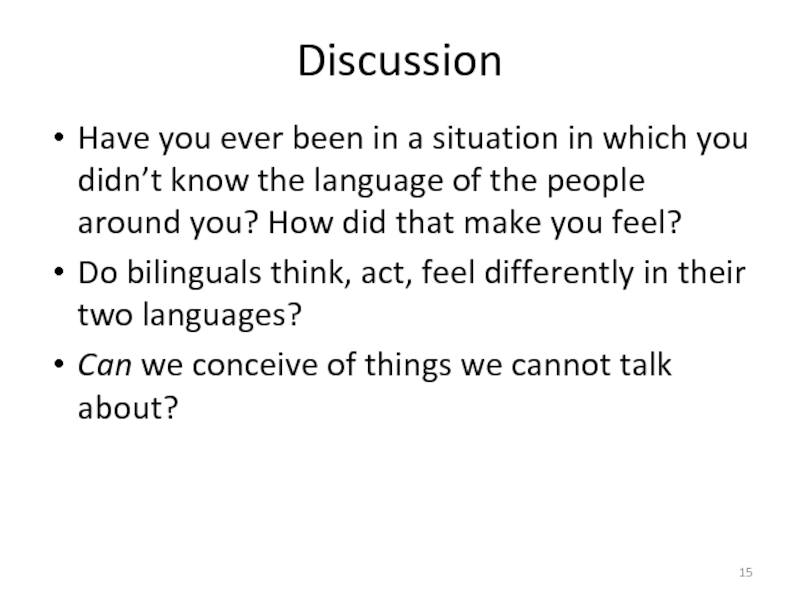
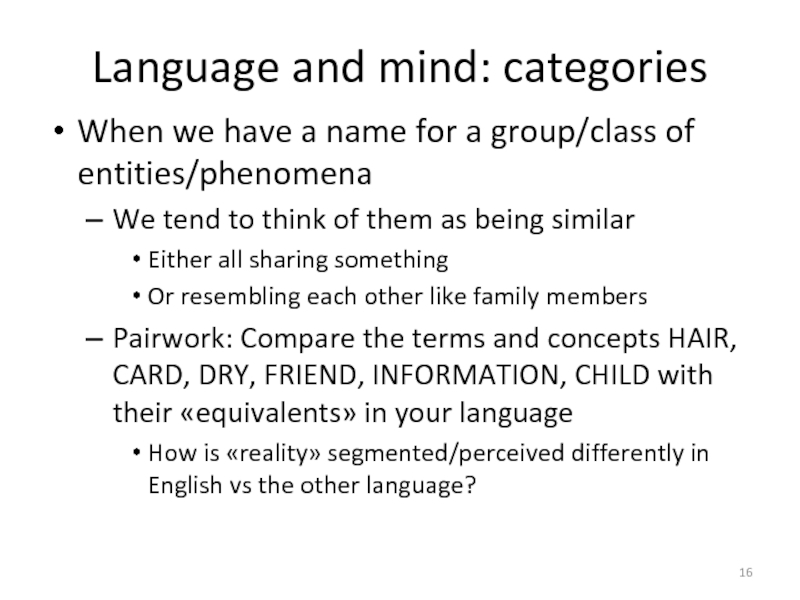
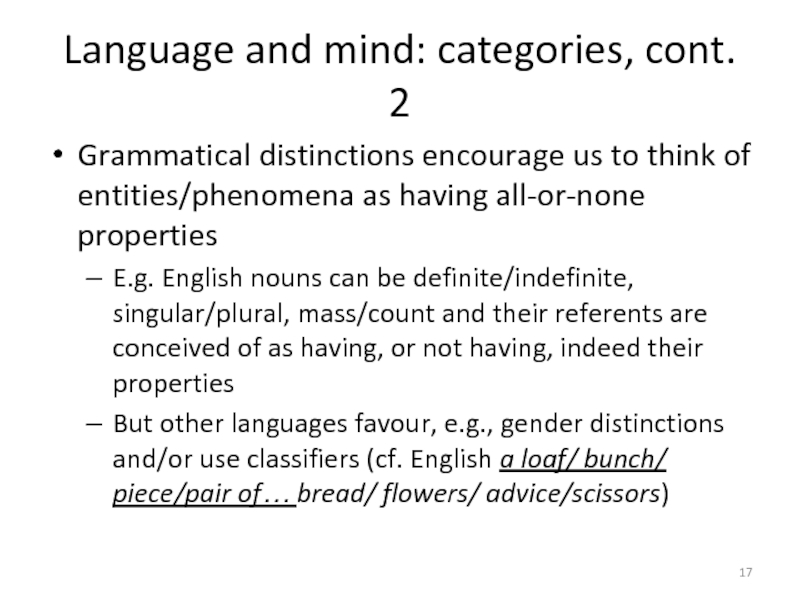
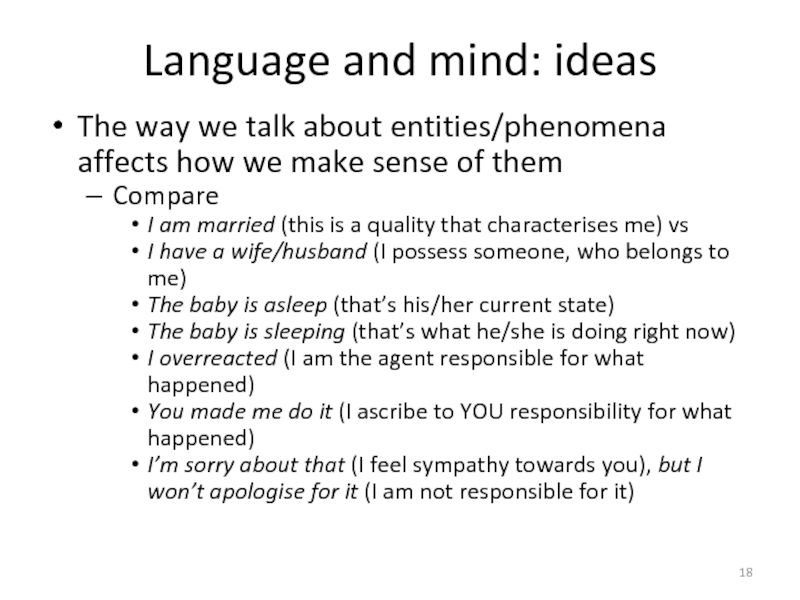
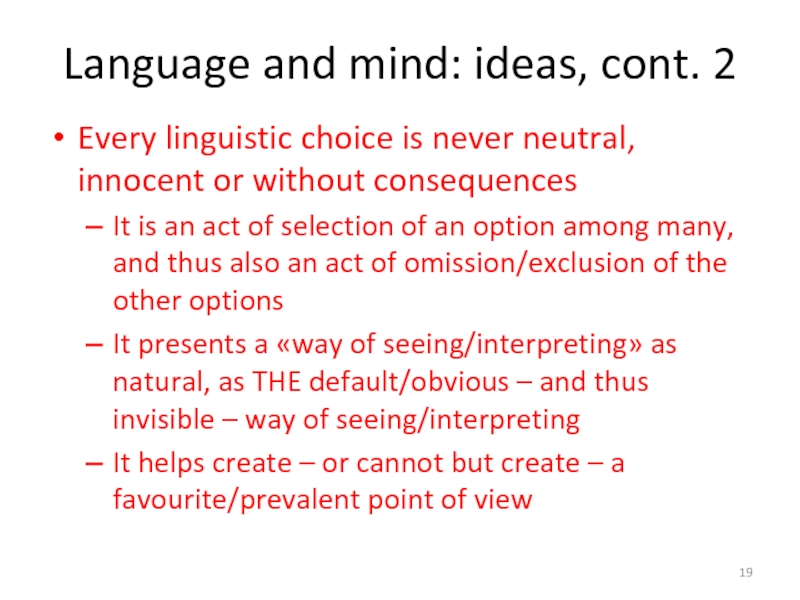
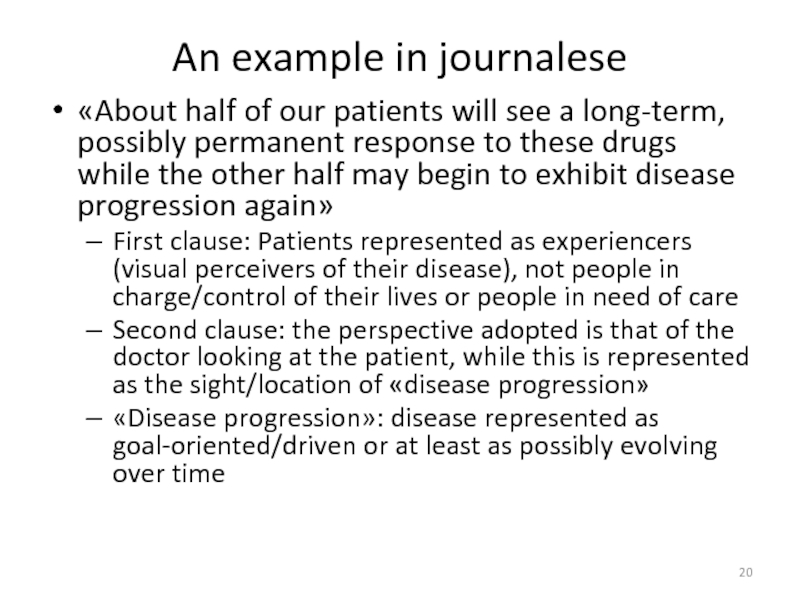
![An example in journalese, cont. 1«About half of our patients [… ]»The mini-report technically and](/img/tmb/4/340057/0ead9f87eed27cf603db7529e82c788f-800x.jpg)
